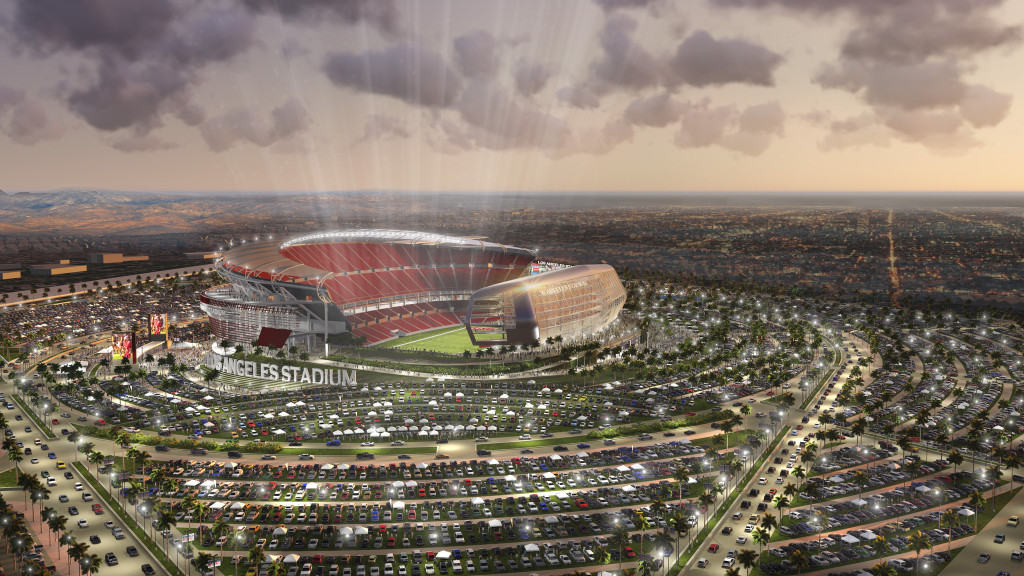
(By Nick Green, Daily Breeze)
Anschutz Entertainment Group, owner of Carson’s 125-acre StubHub Center, has warned Mayor Jim Dear in a letter that fast-tracking a “deeply flawed” NFL stadium proposal and avoiding an extensive environmental analysis “is an open invitation to litigation.”
In the six-page-letter, AEG maintained there are “numerous environmental and operational impacts” between the sports complex on the campus of Cal State Dominguez Hills — home to Major League Soccer’s Los Angeles Galaxy — and the proposed NFL site on Avalon Boulevard about 2 miles to the south.
The “substantial overlap” between the NFL and MLS seasons could create significant effects on traffic, parking and police and fire services given the proximity of the two venues, argued Ted Fikre, AEG’s chief legal and development officer.
Fikre said Carson’s leaders should “be mindful of ensuring the continued success of the StubHub Center and the Galaxy.”
“As one of Carson’s biggest investors and business stakeholders, AEG has an interest in advocating for a responsible approach to major developments in the community,” Fikre said.
This is the second time that AEG, which last week abandoned longtime plans to build an NFL venue in downtown Los Angeles, has launched an attack on a competing Southern California stadium proposal.
Last month, the global sports franchise and arena owner and operatorcommissioned a report by former Secretary of Homeland Security Tom Ridge that maintained the Inglewood NFL stadium site represented a security risk as a potential terrorist target. It sits under the Los Angeles International Airport flight path on the former Hollywood Park racetrack.
Supporters of the Inglewood and Carson proposals have collected signatures with the goal of showing significant public support for the projects.
In Inglewood, which dreams of luring the Rams from St. Louis back to Los Angeles, backers quickly collected 20,000 signatures. That prompted the City Council to bypass a public vote and begin laying a foundation for the stadium development process itself.
Much to AEG’s alarm, the goal in Carson is to put the 72,000-capacity stadium on a similar track. The NFL’s Chargers and Raiders have both expressed interest in sharing the facility if they are unable to hammer out new stadium deals in San Diego and Oakland.
“With the proposed initiative, there is no review under (state environmental law), no public process and no public dialogue about the types of benefits provided by other large-scale projects such as the ones AEG has developed through a thorough and transparent public process involving extensive community input,” the company wrote. “We have a very substantial investment in Carson, which will be placed at risk if a loophole is exploited to avoid and evade the protections described above.”
Dear on Tuesday declined substantive comment and would not be drawn in on whether AEG was obliquely threatening a lawsuit in its lengthy letter.
“They’re bringing up a lot of legal issues here,” Dear said. “I’m going to pass it on to the city attorney.”
Sunny Soltani, the city attorney, did not respond to a message left seeking comment.
More than 1 million fans a year visit StubHub Center, which hosts cycling, boxing, tennis, concerts and other events in addition to Galaxy and international games.
Carson had little say over the development of AEG’s athletic complex on the university campus, which opened in 2003 and was approved by the California State University Board of Trustees.
The next year AEG won conceptual approval for a 200-room conference center and hotel with a restaurant, sports bar and coffee shop adjacent to the grassy berm that overlooks the north end of the soccer stadium, which has a maximum capacity of 27,000. The $60 million project was never built.
The NFL stadium proposal includes up to 850,000 square feet of associated commercial development, including a 350-room hotel on the site, a former garbage dump.
However, AEG noted that only 10,000 parking spaces are required for the entire project.
In a sense, AEG is resurrecting fears over excessive traffic that opponents of its own project raised initially.
Indeed, the city backed the project in 2001 — then-councilman Dear held the swing vote — only after AEG threatened to kill the sports complex without municipal support.
Neighbors who opposed the project were furious at the time.
“We were sold out by the mayor and council members,” said Irene Williams, who lives near the university. “They’re not concerned about the citizens of Carson. They’re concerned about what we can get out of this.
